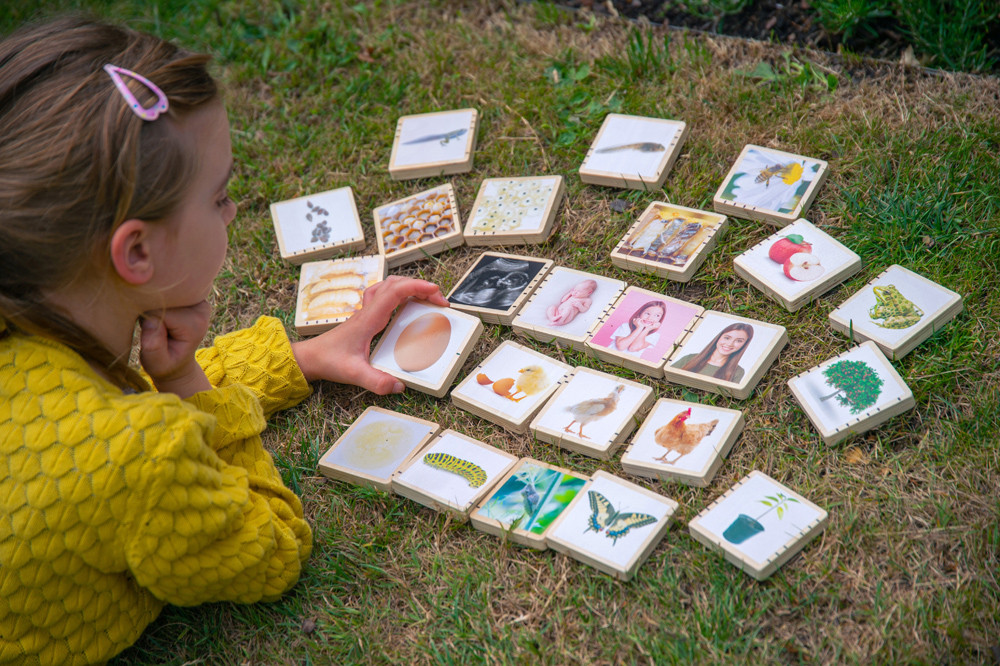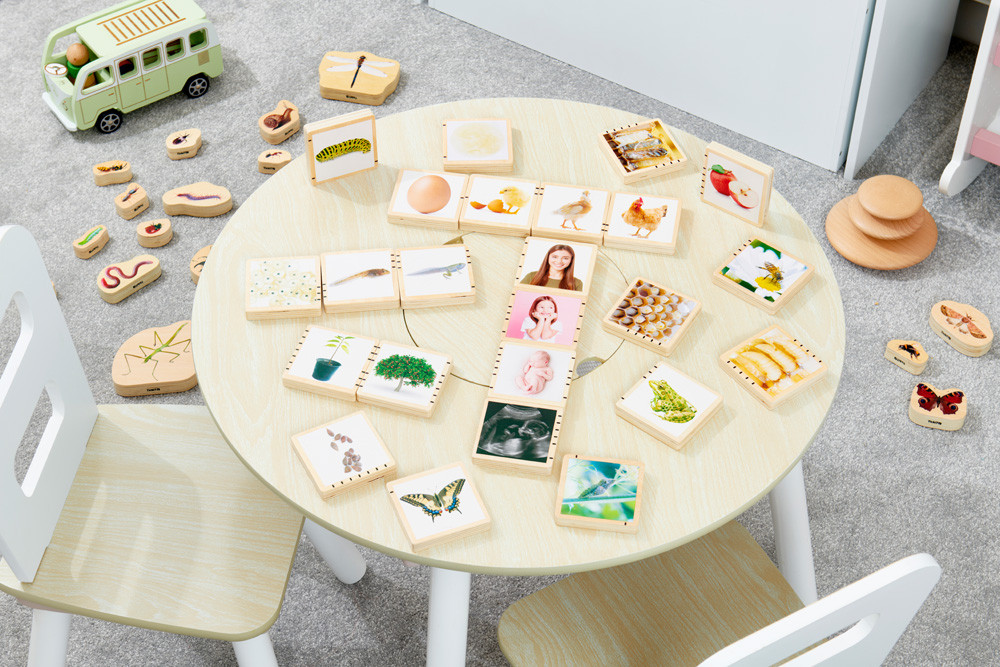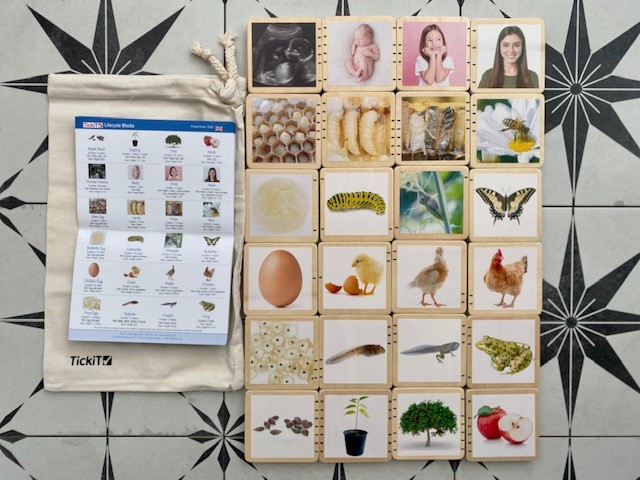tickit® Wooden Lifecycle Tiles come as a set of 24 smooth birch plywood square tiles. Each tile is clearly colour printed on one side with real photographic lifecycle images. Showing 4 stages for each lifecycle, the self-correcting tiles illustrate the growing and development process of humans, bees, frogs, apples, butterflies and chickens.
Rachel Comfort, a primary school teacher, has used these in her lessons. We contacted her to gain her feedback on the set.
The new wooden lifecycle tiles provide an exciting learning opportunity for early years and primary school children. Conceptual understanding, that is to understand more than isolated facts, and therefore be able to transfer knowledge between subjects, is a fundamental skill for all learners. This resource is supporting the development of conceptual understanding as it isn’t limited to one specific lifecycle. Instead, it pulls together threshold concepts, which is the foundational understanding that all species have a lifecycle, but these lifecycles do differ.
By having concrete visuals, which are designed to show a sequence, children can develop this conceptual understanding in a more sensical manner. Not only does this resource allow children to explore mixing and matching different species together, but they are also gently guided to matching the species correctly by coordinating the markings on the edge of the tiles. Like a puzzle, this allows the children to investigate life cycles independently, only to be scaffolded, or supported, as required.
These tiles use real life images of a variety of species, allowing children to relate this learning to real life. Often early years science resources use animated images to demonstrate real life concepts, however this can lead to huge misconceptions between fiction and real life. The tiles are not limited to human or plant life cycles either, instead they develop the understanding that birds lay eggs, plants grow from seeds and bees from larvae. This further develops children’s understanding of the different classes of animals, thus linking back to threshold conceptual understanding, which is transferable to other lifecycles.
Resources which are designed to be played with give opportunities for discussion and for educators or carers to question a child’s understanding and therefore manage misunderstandings, or misconceptions, as they arise.
I think most importantly, as a resource available in an early year’s classroom, these tiles allow for organic learning in an inquiry-based learning environment, which some believe is where the most meaningful learning takes place.
As soon as I saw these tiles, I was excited to order some, however, I plan to assess the way they are used with a group of year 1 pupils. As part of this case study, I will assess the pupils current conceptual understanding of lifecycles, before giving the tiles to the class to be used as a child initiated, inquiry-based resource. When the children use the tiles, I will be available to answer any questions as they arise.
Another key thing to consider is that learning about life cycles is covered across all key stages from 1 to 3, therefore, offering pupils the chance to explore this key scientific area could be fundamental in creating a love of learning.
Case Study
A group of 8 pupils from Early Years and Year 1 were invited to come and play with a new toy.

I asked: Do you know anything about life cycles?
Year 1 pupil: “yes, plants have a life cycle, they start as a seed then grow into a flower”.
I then gave the pupils the box of tiles to open and see what they did with them.
To begin with the pupils riffled through the tiles to see the pictures. They weren’t making much sense of them, until they came across a familiar image, such as the human, chick, or bee.
Year 1 pupil: “I see a human one”.
Within a few minutes the pupils noticed that some of the tiles went together.
EYFS pupil: “that needs to go there”.
Year 1 pupil: “oh, I know, put them in a line!”
Although the full life cycle of the human was not yet complete, a pupil noticed the pattern within life cycles and that there were more than one.
EYFS pupil: “now we can do the plant one”.
There was a clear sense of achievement when playing with the tiles.
I noticed the pupils had made no connection to the lines on the side of the tiles yet. I pointed this out to ask them what they thought the lines meant. One pupil looked and started moving the tiles, without saying anything. They noticed that not all the lifecycle parts were in the right place. This prompted the children to work together and discuss how to “fix” the life cycles. The pupils needed very little adult input with this activity as this was seen as playing and therefore, there was no concern about getting it wrong.
EYFS pupil: “oh, it’s not a mashed potato ball, it’s part of the butterfly lifecycle!”
Year 1 pupil: “Wow, that’s the lifecycle of the bee”.
Year 1 pupil: “oh wait, this one doesn’t connect”. The pupil then scanned the tiles to work out where the tile fits within a life cycle.
EYFS pupil: “I really liked that. Can we play with them again?”

Following this activity, I asked the pupils if they remembered anything about the tiles I had shown them. They all called out the different lifecycles they had seen, interestingly, none of the children mentioned the plant lifecycle, which was the only one they had been taught in science. This demonstrates the power of independently chosen play activities on the development of new knowledge and retaining it.
Addressing misconceptions is hugely important in education. The longer a misconception is believed, the harder it is to break. The way these tiles help pupils to address their own misconceptions is wonderful. When we realise our own mistakes, our self-esteem and confidence is far less likely to be affected. As demonstrated when asking the same pupils what they now know about life cycles, they recalled the knowledge they taught themselves when playing with the lifecycle tiles, over the knowledge imparted on them by their teacher.
Finally, it has been proved many times, but it is important to remember that the knowledge acquired through independent play improves the cognitive, physical, social, and emotional well-being of children and young people.



